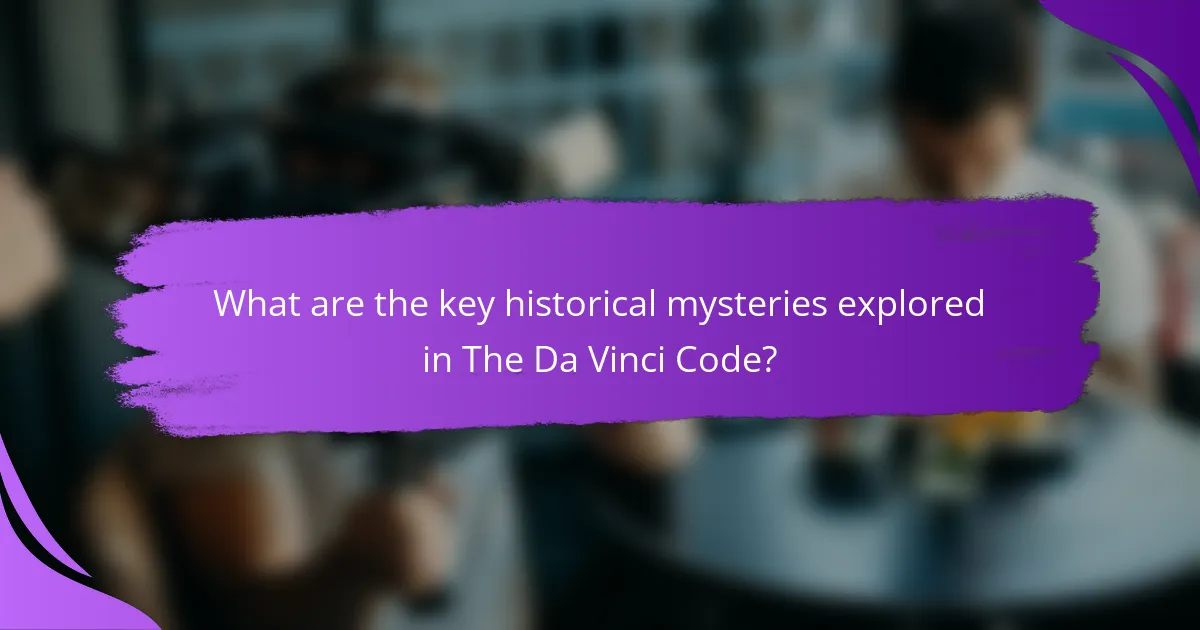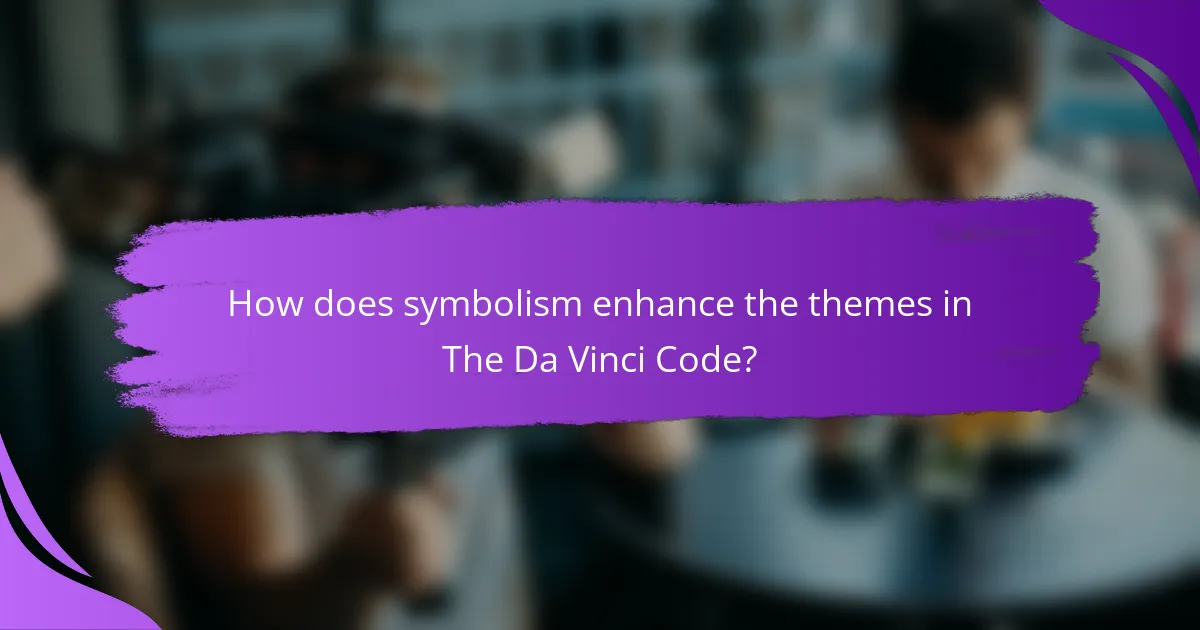Dr. Robert Langdon is a central character in The Da Vinci Code, known for his expertise in symbology, history, and art. The article explores Langdon’s analytical skills and critical thinking as he deciphers historical mysteries, including the true nature of the Holy Grail and the hidden messages in Leonardo da Vinci’s artwork. It highlights the role of symbolism in the narrative, connecting themes of faith, knowledge, and the quest for truth. The examination of the Priory of Sion and the conflict between science and religion further enriches the story. Overall, the article delves into how Langdon’s character and the intricate symbolism enhance the thematic depth of The Da Vinci Code.

What makes Dr. Robert Langdon a genius in The Da Vinci Code?
Dr. Robert Langdon is a genius in The Da Vinci Code due to his extensive knowledge of symbology and history. He possesses a deep understanding of art, religion, and mythology. Langdon’s expertise allows him to decipher complex symbols and codes throughout the narrative. He connects historical events with contemporary issues seamlessly. His analytical skills enable him to solve puzzles that others cannot. Langdon’s ability to think critically under pressure is evident in high-stakes situations. He often draws on academic research to support his conclusions. His character embodies the intersection of intellect and curiosity, making him a compelling protagonist.
How does Langdon’s expertise in symbology contribute to the narrative?
Langdon’s expertise in symbology is crucial to the narrative. His knowledge allows him to decipher complex symbols and codes. This skill drives the plot forward by uncovering secrets hidden in art and history. For instance, he interprets the Mona Lisa and the Last Supper, revealing deeper meanings. These interpretations lead to significant revelations about the Holy Grail and religious history. Additionally, Langdon’s insights create tension and intrigue, as characters pursue him for answers. His expertise positions him as a key figure in solving the mysteries presented in the story. Overall, his symbology knowledge is integral to the unfolding of the narrative.
What specific symbols does Langdon decode throughout the story?
Langdon decodes several specific symbols throughout the story. He interprets the Mona Lisa’s smile as a clue. He also analyzes the Vitruvian Man to understand human proportions. The rose line, or meridian, is another significant symbol he deciphers. Additionally, he examines the significance of the Fibonacci sequence. Langdon also interprets the symbols of the Priory of Sion. He engages with various religious symbols, including the chalice and the sword. Each symbol plays a crucial role in unraveling the mystery of the story.
How does Langdon’s knowledge of history enhance the plot?
Langdon’s knowledge of history enhances the plot by providing context and depth to the narrative. His expertise allows him to decode symbols and historical references that are crucial to the storyline. For example, Langdon interprets the significance of the Mona Lisa and its relation to the quest for the Holy Grail. This understanding drives the plot forward by revealing hidden connections between art, history, and religion. Additionally, his historical insights help to unravel the mystery surrounding the Priory of Sion and its secrets. This knowledge not only aids in solving puzzles but also creates tension and intrigue as characters navigate a web of historical truths and myths. Ultimately, Langdon’s historical acumen is essential for the progression of the plot and the resolution of its central mysteries.
What role does Langdon’s character play in unraveling historical mysteries?
Langdon’s character serves as a key investigator in unraveling historical mysteries. He applies his expertise in symbology and history to decode complex symbols and artifacts. His analytical skills enable him to connect seemingly unrelated clues. Langdon often collaborates with other characters to piece together the narrative. His knowledge of art and literature provides context for the mysteries he encounters. For instance, he interprets the significance of the Mona Lisa in “The Da Vinci Code.” This interpretation reveals deeper meanings tied to historical events. Langdon’s character ultimately drives the plot forward through his relentless pursuit of truth.
Which historical events are central to the story’s themes?
The central historical events in “The Da Vinci Code” include the Renaissance period and the events surrounding the Knights Templar. The Renaissance significantly influences the story’s exploration of art, religion, and humanism. Key figures, like Leonardo da Vinci, play a crucial role in revealing hidden messages in their works. The Knights Templar’s historical context introduces themes of secrecy and religious conflict. Their alleged guardianship of sacred knowledge adds depth to the narrative’s mystery. Events such as the Council of Nicaea are pivotal in shaping the religious themes within the story. These events collectively underscore the tension between faith and reason.
How does Langdon’s perspective influence the interpretation of these events?
Langdon’s perspective significantly shapes the interpretation of events in “The Da Vinci Code.” His scholarly background in symbology allows him to analyze symbols and historical contexts deeply. This expertise leads him to uncover hidden meanings that others might overlook. For instance, his interpretation of the Mona Lisa reveals connections to historical secrets. Langdon’s insights often challenge conventional beliefs, prompting readers to reconsider established narratives. His critical thinking encourages exploration of alternative viewpoints, enhancing the storyline’s complexity. Consequently, Langdon’s perspective is essential for understanding the intricate layers of meaning within the events of the narrative.

What are the key historical mysteries explored in The Da Vinci Code?
The key historical mysteries explored in The Da Vinci Code include the Holy Grail’s true nature. The novel suggests it may represent a bloodline of [censured]. Another mystery is the interpretation of Leonardo da Vinci’s artwork. The Last Supper and Mona Lisa contain hidden messages and symbols. The Priory of Sion is also a central element. It is portrayed as a secret society protecting sacred truths. The book examines the conflict between science and religion. It questions historical narratives shaped by the [censured]. These mysteries are woven into a narrative that blends fiction with historical references.
How does the quest for the Holy Grail shape the storyline?
The quest for the Holy Grail is central to the storyline of “The Da Vinci Code.” It drives the plot and motivates character actions. The Grail symbolizes truth and enlightenment throughout the narrative. Characters like Robert Langdon and Sophie Neveu seek the Grail to uncover hidden knowledge. Their journey explores themes of faith, history, and conspiracy. The quest reveals historical connections and challenges established beliefs. It also creates tension and conflict among characters. Ultimately, the Grail quest shapes the story’s resolution and character development.
What theories about the Holy Grail are presented in the book?
The book presents several theories about the Holy Grail. One theory suggests that the Grail is not a physical object but rather a symbol of divine feminine power. This theory is supported by the idea that Mary Magdalene is depicted as the Grail in the context of sacred lineage. Another theory posits that the Grail represents a hidden truth about [censured], specifically the notion of Jesus’ bloodline. This theory is reinforced by references to historical texts and symbols throughout the narrative. The book also explores the idea that the Grail is linked to ancient pagan rituals and the worship of the goddess. This connection highlights the blending of Christian and pre-Christian beliefs. Overall, these theories challenge traditional views and encourage readers to reconsider the Grail’s significance.
How do these theories challenge traditional narratives?
These theories challenge traditional narratives by presenting alternative interpretations of historical events. They question established beliefs regarding religion, art, and historical figures. For instance, they suggest that certain religious texts have been manipulated for power. This contradicts the conventional view that these texts are purely sacred. Additionally, these theories highlight the role of women in history, often overlooked in traditional narratives. They emphasize the significance of symbols and hidden meanings in art. This approach encourages a re-examination of accepted historical truths. By doing so, they invite readers to critically analyze the sources of their knowledge.
What significance do the artworks featured in the novel hold?
The artworks featured in the novel symbolize deeper historical and cultural themes. They serve as critical plot devices that drive the narrative forward. Each piece of art contains hidden messages and clues relevant to the mystery. For example, Leonardo da Vinci’s works are pivotal in exploring themes of faith and knowledge. The paintings challenge characters to decipher meanings that reflect the tension between science and religion. Additionally, the artworks connect readers to real historical contexts, enhancing engagement with the story. Their significance lies in their ability to provoke thought and discussion about art’s role in society. Ultimately, they enrich the narrative by intertwining art with the unfolding mystery.
How does Langdon analyze Leonardo da Vinci’s works?
Langdon analyzes Leonardo da Vinci’s works through a detailed examination of symbols and hidden meanings. He identifies significant elements within the artwork that relate to historical and religious contexts. Langdon employs art historical knowledge to interpret da Vinci’s techniques and intentions. He connects the visual elements to broader themes in history and theology. This analytical approach reveals deeper insights into the narrative of “The Da Vinci Code.” Langdon’s analysis often involves cross-referencing da Vinci’s works with historical texts and artifacts. He emphasizes the importance of understanding the cultural background of the Renaissance period. This method allows Langdon to uncover layers of meaning that are not immediately apparent.
What hidden messages are revealed through the art analysis?
Art analysis reveals hidden messages related to historical context, symbolism, and cultural commentary. Through examination of visual elements, one can uncover deeper meanings. For instance, in “The Da Vinci Code,” Leonardo da Vinci’s works are analyzed for clues about religion and power dynamics. The use of light and shadow often symbolizes knowledge versus ignorance. Additionally, specific colors can convey emotions or societal critiques. The placement of figures within the artwork may suggest relationships or hierarchies. Such analyses highlight how art serves as a vehicle for commentary on contemporary issues. This method of interpretation allows viewers to engage with the artwork beyond its surface.

How does symbolism enhance the themes in The Da Vinci Code?
Symbolism enhances the themes in The Da Vinci Code by providing deeper layers of meaning. The use of symbols, such as the Mona Lisa and the Holy Grail, connects to themes of faith, knowledge, and the quest for truth. These symbols challenge characters and readers to explore hidden messages and historical contexts. For example, the Mona Lisa symbolizes the intersection of art and science, reflecting the struggle between faith and reason. Additionally, the Holy Grail represents the search for divine truth and the questioning of established beliefs. This interplay of symbolism encourages readers to engage with the narrative on a philosophical level. Through these symbols, the novel critiques religious dogma and promotes intellectual inquiry. Thus, symbolism is vital in shaping the thematic structure of The Da Vinci Code.
What are the main symbols used throughout the novel?
The main symbols used throughout the novel include the Mona Lisa, the Holy Grail, and the rose. The Mona Lisa represents the intersection of art and mystery. It serves as a key to understanding deeper themes in the narrative. The Holy Grail symbolizes the search for truth and enlightenment. It embodies the quest for knowledge that drives the protagonist. The rose often represents love and secrecy, reflecting the personal relationships within the story. Each symbol enhances the narrative’s complexity and enriches the reader’s experience. These symbols are integral to unraveling the historical and thematic layers of the plot.
How do these symbols relate to the overarching themes of faith and reason?
Symbols in “The Da Vinci Code” illustrate the tension between faith and reason. Faith is represented through religious iconography, suggesting deep spiritual beliefs. Reason is depicted through scientific and historical analysis, emphasizing logical inquiry. The interplay between these symbols creates a dialogue about truth. For example, the conflict between the [censured] and scientific discovery highlights this theme. The symbols provoke questions about belief systems and knowledge. They encourage readers to explore the balance between faith and rational thought. This duality is central to the narrative’s exploration of historical mysteries.
What unique interpretations does Langdon provide for these symbols?
Langdon provides unique interpretations of symbols such as the Mona Lisa and the Vitruvian Man. He suggests that the Mona Lisa embodies the concept of feminine mystique and hidden knowledge. Langdon argues that the painting’s smile represents a deeper understanding of life and death. For the Vitruvian Man, he interprets it as a symbol of human potential and the connection between man and the universe. Langdon highlights the geometric proportions as a reflection of harmony in nature. His interpretations draw on historical context and artistic techniques. These insights reveal layers of meaning that challenge conventional perceptions. Langdon’s analysis emphasizes the importance of symbols in understanding cultural history.
Why is Langdon’s character essential for decoding the symbolism?
Langdon’s character is essential for decoding the symbolism due to his expertise in symbology and history. He possesses a deep understanding of various symbols and their meanings. This knowledge allows him to interpret complex clues throughout the narrative. Langdon’s analytical skills enable him to connect historical contexts to modern symbols. His background as a professor provides credibility to his interpretations. Additionally, his curiosity drives the plot forward, leading to discoveries. The author, Dan Brown, crafts Langdon as a guide through intricate puzzles. This character’s insights are critical for the reader’s understanding of the symbolism presented in the story.
How does Langdon’s background influence his interpretations?
Langdon’s background as a Harvard symbologist significantly influences his interpretations. His extensive knowledge of art history, religion, and symbols allows him to decode complex messages. This academic foundation shapes his analytical approach to historical texts and artifacts. For instance, his understanding of religious symbolism helps him interpret the hidden meanings in works like the Mona Lisa. Additionally, Langdon’s familiarity with historical contexts enhances his ability to connect past events with present mysteries. His character often draws on scholarly research, which informs his conclusions. Overall, Langdon’s expertise provides a lens through which he perceives and solves intricate puzzles.
What challenges does Langdon face in deciphering these symbols?
Langdon faces multiple challenges in deciphering the symbols. One challenge is the complexity of the symbols themselves. Many symbols have layered meanings that require extensive knowledge of history and art. Another challenge is the time pressure he experiences during his investigations. He often needs to solve puzzles quickly to prevent further chaos. Additionally, Langdon encounters conflicting interpretations of the symbols from various characters. These differing views can lead to confusion and misdirection in his analysis. Lastly, the symbols are often hidden or obscured, requiring Langdon to think creatively and observe details that others might miss.
What practical insights can readers gain from Langdon’s journey?
Readers can gain insights into critical thinking and problem-solving from Langdon’s journey. Langdon’s analytical skills demonstrate the importance of examining evidence closely. He often connects historical symbols to modern contexts. This encourages readers to think creatively and make connections in their own lives. Additionally, Langdon’s exploration of history emphasizes the value of understanding cultural heritage. Readers learn that knowledge of the past can inform present decisions. His experiences also highlight the significance of teamwork in overcoming challenges. Collaborating with others can lead to more comprehensive solutions. Overall, Langdon’s journey illustrates how curiosity and persistence can lead to valuable discoveries.
How can understanding symbolism enhance everyday life?
Understanding symbolism can enhance everyday life by providing deeper insights into human experiences. Symbolism allows individuals to interpret complex ideas and emotions effectively. It enriches communication by enabling people to convey meanings beyond literal words. This understanding fosters empathy and connection among individuals. For instance, recognizing symbols in art or literature can lead to greater appreciation and critical thinking. Studies show that individuals who engage with symbolic content exhibit improved cognitive skills. This engagement can lead to better problem-solving abilities in real-life situations. Overall, mastering symbolism can significantly improve interpersonal relationships and personal growth.
What lessons about critical thinking can be learned from Langdon’s approach?
Langdon’s approach teaches several critical thinking lessons. He emphasizes the importance of questioning assumptions. This encourages deeper exploration of topics. Langdon also demonstrates the value of interdisciplinary knowledge. He combines history, art, and science to solve complex problems. Another lesson is the need for skepticism. He critically evaluates sources and claims before accepting them as true. Additionally, Langdon showcases the power of pattern recognition. He identifies connections between seemingly unrelated elements. These lessons highlight the necessity of a comprehensive and analytical mindset in critical thinking.
The main entity of this article is Dr. Robert Langdon, a character from The Da Vinci Code, known for his exceptional expertise in symbology and history. The article examines Langdon’s role as a genius investigator who decodes complex symbols and historical mysteries, driving the narrative forward. Key discussions include his analytical skills, the significance of symbols such as the Holy Grail and the Mona Lisa, and how his knowledge of history enhances the plot. Additionally, the article explores the interplay between faith and reason, as well as practical insights and critical thinking lessons that readers can derive from Langdon’s journey.